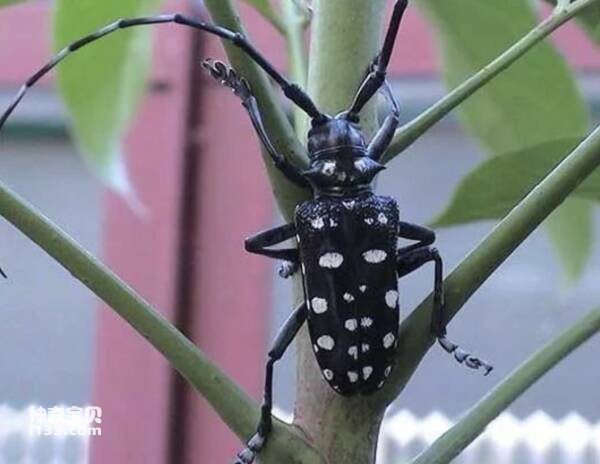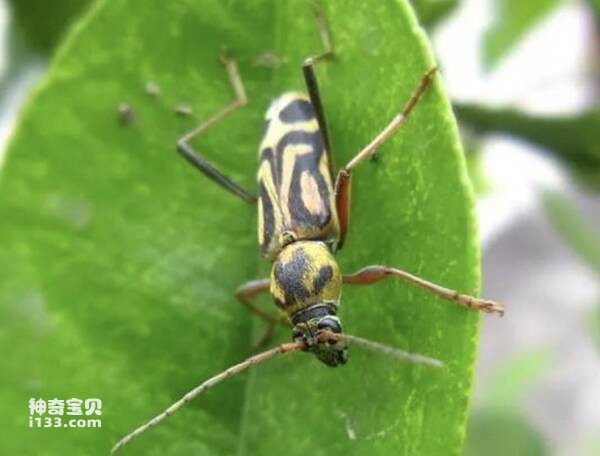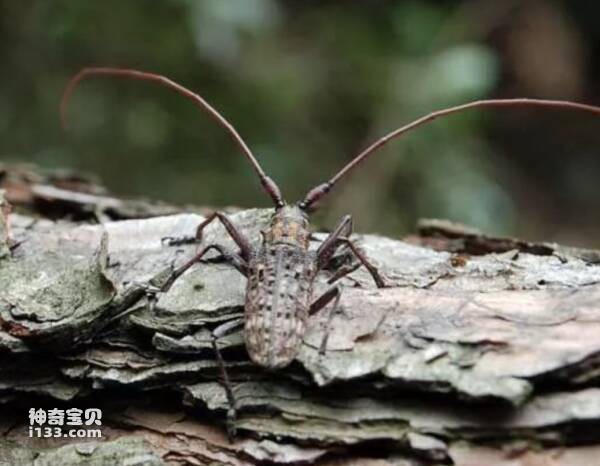Longhorn beetles are a well-known type of insect. Many people have caught or observed beetles when they were children and became interested in them. The interesting thing is that when you grab it, it will make a "crunching" sound in an attempt to break free and escape. If you tie a thin string to its legs and let it fly, you can still hear the sound of "camping". There are many ways to play with beetles, such as beetle racing, beetle pulling carts, beetle fish, beetle racing, etc. Compared with the electric toys currently flooding the market, playing with this "natural pet" is much more interesting. However, I would like to remind everyone that when playing, be careful not to get your hand bitten by the strong upper jaw of the beetle! There is a popular game of "Beetle Fishing" among the people, which is very amusing. The method is to place a small fish-shaped piece in a basin filled with water, tie it with a thread through a hole, and tie the other end to the horn of the longhorned beetle with a moderate length of thread. Place the longhorned beetle on another small wooden strip and float it on the water, with the longhorn around. Surrounded by water, feeling uneasy and waving its tentacles frequently, it is like fishing. If the fish leaves the water, the fishing is successful. It's like a competition between two insects. The one who catches it first wins, which is very interesting.

In production practice, the working people of our country have long known that beetles are tree-eating pests. Li Shizhen said in "Compendium of Materia Medica": "Beetles are found everywhere, and... they are transformed by tree beetles." These two sentences fully demonstrate people's understanding of the commonness and harmfulness of beetles. There is a poem by Su Dongpo: "The two horns grow on their own, and they fly in the air without obeying the box. What's the benefit of being an ox? It kisses the hole and withers the mulberry." From this, we can see the poet's ridicule and exclamation of the beetle, and at the same time it also reflects The people's hatred of the longhorned beetle: Although the longhorned beetle has horns like those of a cow and has the reputation of a cow, it is not as beneficial to people as a cow. Instead, it harms mulberry trees with their sharp kisses!
Longhorn beetles cause the most damage to plants in their larval stage. Although adults can sometimes cause more or less damage due to laying eggs and feeding on branches and leaves, it is generally not serious. The interior of trees is eroded by larvae, which often hinders their normal growth, reduces yields, weakens tree vigor, and shortens lifespan; when the damage is severe, it can even lead to rapid withering and death of trees. Trees that are eaten away by woodworms are often prone to the invasion of other pests and pathogens, and are easily broken by strong winds. When wood is damaged by woodworm, the quality will inevitably decrease and even lose their craft value and commercial significance. If the stems and roots of herbaceous plants are damaged by larvae, it will also cause crop yield reduction, withering or death. It has been repeatedly recorded in the literature that the adults and larvae of a beetle can sometimes attack metal materials such as lead sheets, lead wires, etc. In 1957, a project in Guiyang found that the lead sheets of two cables in the telephone cables shipped from Shanghai were bitten by adult beetles, causing the copper coins inside to be exposed.
After the wood inhabited by beetles is made into woodenware, it can also cause damage to debris. A bundle of books at the Beijing Xinhua Bookstore Storage and Transportation Company was invaded by a beetle larvae, which eroded a tunnel in the five overlapping books. Therefore, the economic significance of beetle damage is very important, especially for fruit trees and forests. They are an extremely serious threat and cause great losses to people.

1. Types and distribution of beetles
There are many types of longhorned beetles. There are more than 25,000 known species in the world, and there are about 2,200 species in my country. They are widely distributed and cause widespread damage. Almost every tree is affected by different types of longhorned beetles. Among the trees that suffered more damage, there were 28 species of longhorned beetles in mulberry trees, 25 species of willows and poplars, 18 species of citrus trees, and 23 species of pine trees.
Typical beetle species have a long cylindrical body, a slightly flat back, and long antennae, especially the more common ones, such as star beetles, mulberry beetles, cloud-spotted beetles, etc., with their sturdy bodies and protruding The two horns make people realize the impression of cattle. In fact, the body shape and size of beetles also vary quite a lot. Some have shorter antennae, some have oval or other shapes, and some imitate the image of other insects. For example, short-winged beetles and tiger beetles are very similar to bees. . Longhorn beetles are also known for their beautiful colors, but many species are more or less brown, or arranged in spots, which matches the color of the trunk and serves as a concealing or protective color.
Most beetles are large or medium-sized species, ranging from 15 to 50 mm in length. But there are also very large ones, such as the Great Mountain Saw Beetle, with a body length of up to 110 mm, and smaller ones, such as the Tiny Beetle, with a body length of only 4.5-6 mm. Sometimes there is great variation in size between individuals of the same species. For example, the body length of the star beetle is 19-39 mm, and the body width is 6-14 mm.
2. Living habits of beetles
Longhorn beetles are mainly pests of woody plants, eating trunks, branches and roots in their larval stage. Some are harmful to herbaceous plants, with larvae living in stems or roots, such as Chrysanthemum beetles, Melon beetles, etc. Some species, such as Capsella gossypii, are harmful to Capsicum gossypii. There are also a few species whose larvae do not live in plant tissues, but feed on roots in the soil, such as big-toothed and bent-toothed saw beetles, grass beetles, etc.
Not much is known about the feeding habits of adult insects, but it is known that they have different habits of feeding on pollen, tender bark, twigs, leaves, roots, sap, fruits, fungi, etc. Generally speaking, beetles often feed on pollen. Longhorn beetles often feed on tender bark, twigs and leaves. Adults of other subfamilies also feed, and some may not feed. Food habits also vary greatly within the same subfamily.
The length of the beetle's life history varies depending on the species. Some may complete one or two generations in one year, while others may complete one generation in two, three, or even four or five years. The life history of the same species in different regions is sometimes very different. For example, it takes three years for the yellow star beetle to complete one generation in Jiangsu, while in Guangdong it has two generations per year. Due to the hidden life of larvae, it is difficult to observe their life history. In addition, the conditions of the host plant, such as age, health, dryness and humidity, etc., have a great impact on the growth and development of the larvae. Adverse conditions often cause diapause of larvae and greatly extend their life span. Therefore, the same species may show different development processes in the same area. There are many records about long-lived larvae in the literature. Most of these are after furniture was made from wood. After a few years, it was suddenly discovered that there were still surviving celestial larvae in it, or the long-lived larvae suddenly emerged, which proved that it had lived in the wood. Many years. There have been many examples proving that beetle larvae can live for one or twenty years, and the two highest records are 40 and 45 years.
Longhorn beetles usually overwinter as larvae, or as adults in the pupa chamber. That is, the adults that emerge in the autumn and winter of the previous year stay in the pupa chamber until spring and summer of the following year. The life span of adults is generally not long, ranging from ten days to one or two months, but adults that overwinter in the pupa chamber may live up to seven or eight months. The life span of male worms is generally shorter than that of female worms. The activity time of adult insects also varies among various species. Some are active in the daylight, and the most active species is the beetle; some are active at night or on cloudy days, or can be active all night.
There are two main methods of laying eggs. One is that the female bites the bark of the tree with her upper mandible (especially the beetle) before laying eggs, and then inserts the ovipositing tube to lay one egg in each hole, or multiple eggs. of. The shape and size of the spawning holes formed in this way often vary among various species, and some are very obvious, which can be used as an indicator to search for and eliminate insect eggs in prevention and control. Another method of laying eggs is not to bite the hole first, but to directly use the ovipositing tube to lay eggs in the gaps in the bark. In a few cases, they are also produced on the smooth parts of the branches. Shiju species lay eggs in the soil.
The newly hatched larvae usually feed under the skin first, and then penetrate deep into the wood after a longer or shorter period of time. A few species only erode under the skin. There are also species that do not penetrate deeply and only damage the sapwood. Many species attack the base trunk or thick branches, some at the roots and others at the branches. When the larvae eat, they dig various tunnels, up or down, left or right, curved or straight, which vary with the species, but there are also many types of tunnels that are very irregular. The tunnel is often filled with insect excrement and fibrous wood chips. Sometimes the insect excrement and wood chips are discharged outward through the worm holes, and sometimes tree sap flows out of the injured area. Mature larvae often build wider tunnels as pupal chambers, with both ends closed with fibrous sawdust, and pupate in them.
The host range of beetles also varies among various species. Many species, such as star beetles, mulberry beetles, clouded beetles, etc., have a wide range of feeding habits and can harm plants of many different families; some are limited to the same family. Or closely related genera, such as Big-toothed Longhorned Beetle and Croton-toothed Longhorn Beetle, which damage grasses, and Red Beetle, which damages camphor trees and Phoebe trees.

3. Prevention and control methods of beetle
The working people of our country have mastered the living habits of beetles in production practice very early, and created a set of prevention and control methods such as searching for eggs, killing larvae with hooks, applying pesticides through insect holes, and catching and killing adults. The "Summary of Sericulture" published more than a hundred years ago has very specific instructions on mulberry insects. The current note is as follows: "There are insects that are born in the bark of mulberry trees, and they are called longhorned beetles. They also lay eggs. After it is full, it will bite the bark of the tree and hide its eggs in the bark. It is also a metamorphic insect, which looks like a maggot after the awn seeds, sucking resin paste. Near the summer solstice, it gradually drills holes and enters. In autumn and winter, it is as big as a grub, with its body It has long legs and short legs. It is called a caterpillar. It eats the heart of trees and penetrates the wood like a cone. It will pupate in March or April next year and transform into a sky buffalo. Its two horns are like a figure eight, black, with white spots on its back, and its upper and lower edges are on the upper and lower sides of the tree. Its mouth is double The pliers are as sharp as scissors, and the new hair will break when bitten. The method of treatment is to pick the bark of the tree itself and the branches where the yellow water flows out, and there are eggs like rice grains in them. Take them and break them. The insect will disappear. If the insect has grown into an adult, you must find the insect hole (there must be moth debris outside the hole); stab the hole with iron wire to kill it, or use the iron wire as a small hook to hook the insect out. If the insect has penetrated deep, it cannot be trapped by the iron wire. If you can reach it, pour it with Baibucao juice, and all of them will die. Or pour cooked tung oil into the hole, or insert firecrackers into the insect holes and burn them with fire. The insects will die when they smell the tung oil gas and the medicine gas. If it has become Water buffaloes in the sky will fly close to the trees, but they will not fly far, so they should be caught quickly."
This method of preventing and controlling mulberry insects shows the high intelligence and creative ability of our country's working people. Their methods can basically still be used by us at present.
Since the 1980s, research on beetle prevention and control has been progressing rapidly, with many achievements made, and some new approaches have been tried. ①Chemical control: Pesticides tried over the years mainly include dichlorvos, phosphatide, dimethoate, dimethoate, fenitrothion, phoxim, fenitrothion, dimethoate, paramethoate, dimethoate, and fluoroacetamide Wait for spraying or painting the trunk. In the pesticide control of fir beetles, longhorned beetles, star beetles, etc. in Henan, Hunan, Sichuan (Chongqing) and other places, it has been proven that spraying 300-500 times of 40% omethoate emulsion has good control effects. ② Sterilization method: Fujian Forestry Research Institute (1980) tried to irradiate the male longhorn beetle with 10,000-30,000 roentgens of 60C0. After mating with the female, the egg laying was not affected, but all the eggs could not hatch. Although it is still in the indoor testing stage, it has been indicated that it has the possibility of utilization. ③ Bait wood trapping: The Chinese Academy of Forestry (1980) used Platycladus arborvitae as bait wood and lured 1,058 double-striped cedar beetles on the oriental orientalis bait wood. At most, more than 500 heads were lured in one day in mid-April. Obvious trapping effect. ④ Management of forest management: Practice has proved that the prevention and control of beetles should be based on silvicultural technical measures, advocating mixed forests, cutting at the right time, rational renewal, and selecting tree species, etc., which are all fundamental measures to implement prevention over cure. ⑤Biological control: The most rapidly developed research work on beetle control in recent years is the use of swollen-legged wasps. Since the discovery of swollen-legged wasps in the insect passages of the long-sheathed long-sleeved long-sleeved long-stalked long-horned long-horned beetle in Guangdong in 1973, and the discovery of the swollen-legged wasps in the worm tumors of the blue poplar long-sleeved long-sleeved long-horned beetle in Shandong in 1975, Guangdong, Shandong, Hunan, Hebei, Beijing, Shanghai, etc. The experiments were carried out on fig beetles, blue beetles, star beetles, etc. Trials of artificial feed have also begun. The results of releasing bees in the field have certain effects. The application of swollen-legged wasps in production requires further research. ⑥X-ray detection: Jiangxi Southern Quarantine Institute (1979) applied the soft X-ray imaging method and created the "Lin 5MX ray detector" to detect beetle larvae in trees and can be used for beetle surveys and wood quarantine work. It can be used as an auxiliary tool in beetle control. In addition, when low-power helium-neon lasers are used to irradiate adult A. macular beetles, their lifespans tend to be shortened. New technologies such as the vacuum nitrogen filling method for preventing and treating beetles in warehoused commodity packaging and bamboo and wood equipment (Chongqing 1979) are also in the preliminary testing stage.
animal tags:
We created this article in conjunction with AI technology, then made sure it was fact-checked and edited by a Animals Top editor.